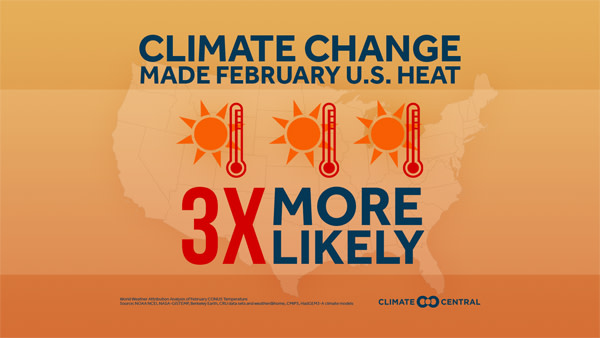Winter was the 6th warmest on record in the U.S., a mark propelled by a phenomenally warm February. The ratio of record highs to record lows established or tied during February was 49-to-1, the highest such monthly ratio since January 1920, when reliable records began.
Comparing its difference from the 20th century average, NOAA reports that February 2017 was the 2nd hottest February and 5th hottest month (by anomaly) on record in the the U.S. The U.S. has only had five months since records began in 1880 where the monthly temperature has been at least 7°F above average.
Our World Weather Attribution team analyzed the role that climate change played in the extreme February warmth in the U.S. The analysis uses both observational data and climate models to look at how rare the event was, and how its likelihood has changed since the end of the 1800s, a time for which we have good temperature observations but global warming had only just started.
The causes of the observed warming can be determined with climate model experiments which can isolate the effects of greenhouse gases, aerosol emissions, solar variability, and volcanic eruptions.
Observations show a trend in February temperatures of 1 to 2.5 times the global mean for the continental United States. The warm February of 1954 was, at the time, a very rare event, but those kinds of temperatures have become increasingly likely as greenhouse gases in the atmosphere continue to mount.
Results from global climate models suggest that recent increases in greenhouse gases have raised the odds of a warm February for the continental United States considerably, while natural forcings such as solar activity, which has declined since the 1960s, or volcanic eruptions did not play a role. Overall, the WWA analysis finds that the chance of seeing a February as warm as the one just experienced across the lower 48 has increased at least threefold.
Extreme warmth such as this will become more common as the level of greenhouse gases in the atmosphere continues to climb. While warmer winters may sound nice, they come with consequences. Some eastern ski resorts have already closed for the season due to this year’s mild weather, something that could become more common in the future. Plants are blooming earlier, raising the risk of damage by a middle or late season frost. Pollen season is getting longer and more intense, increasing the occurrence of respiratory illnesses, like asthma, for those with allergies. And in the West, wildfire season is now 75 days longer than it was in the 1970s due to warmer springs and falls.
You can find the full extreme event attribution methodology here.
